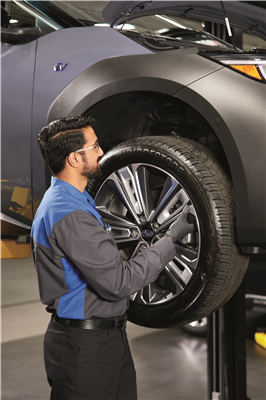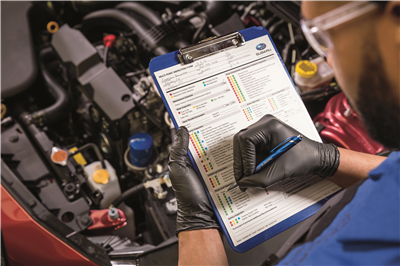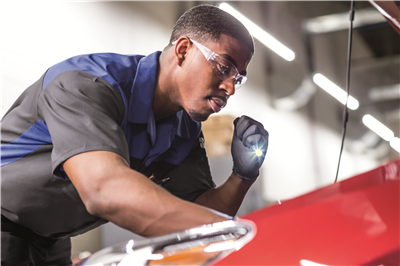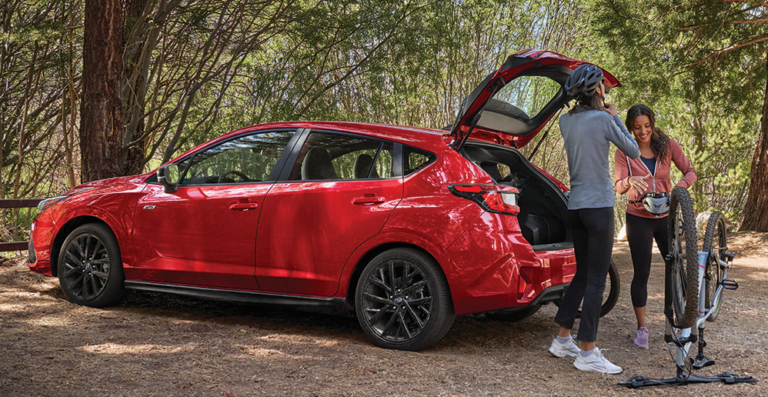The Weight Factor: Heavier EVs Demand More Subaru EV Tire Maintenance
As electric vehicles (EVs) continue to gain popularity, Subaru Solterra owners in Connecticut need to be aware of the unique Subaru EV tire maintenance requirements these vehicles demand, particularly when it comes to tires. Buddy Blichfeldt, a service expert at Quality Subaru in Wallingford, CT, sheds light on the potential for increased tire wear associated with heavier EVs like the Subaru Solterra.
“Well, certainly electric vehicles, they’re gonna be a little tougher on your tires. You know, one of the design characteristics of an electric vehicle, one of the negatives that an electric vehicle has is the weight of the battery. The battery design itself in an electric vehicle can easily weigh one thousand pounds more than its comparable gas-powered vehicle. And that’s because of the battery.”
The Weight Penalty: Brakes Bear the Burden
The substantial weight difference between EVs and their gasoline counterparts is primarily due to the hefty battery packs required to power the electric motors. This added weight translates into increased strain on various components, including the tires.
“So, when you add all that extra weight, there’s a potential for extra wear on the tires.”
As Blichfeldt explains, the additional weight of EVs like the Solterra puts more stress on the tires.
Aggressive Driving: Compounding the Issue
While the weight factor alone contributes to increased tire wear, aggressive driving habits can further exacerbate the problem, regardless of the vehicle’s powertrain. Says Blichfeldt, “so aggressive driving equals more wear, wear on your tires. It’s tempting to accelerate and brake hard in the Solterra because of the fun nature of the vehicle. The way the electric drivetrain develops its power so quickly and is routed to all four wheels makes for almost instantaneously acceleration if you floor the pedal. That frequent hard acceleration and sudden braking can accelerate brake component deterioration and tires, making it essential for EV owners to adopt a careful driving style.”
Regular Inspections: The Key to Timely Replacements

To ensure optimal tire performance and safety, Blichfeldt emphasizes the importance of Subaru EV tire maintenance for Subaru EV owners in Connecticut.
“The best way to know when to get your tires done is to bring your vehicle in for routine maintenance. And at that point, we’re able to check your tires while the vehicle is up on the lift.”
During these inspections, certified technicians can assess the condition of brake pads, rotors, and tires, taking precise measurements to determine if replacements are necessary. Here is a maintenance schedule for your Solterra:
6 Months/5,000 Miles
- Inspect Brake Pads and Discs
- Inspect Steering Linkage
- Inspect Suspension Ball Joints and Dust Covers
- Inspect Drive Shaft Boots
- Perform Tire Rotation Subaru EV Tire Maintenance
- Tighten Bolts and Nuts on Chassis
12 Months/10,000 Miles
- Inspect Brake Pads and Discs
- Inspect Steering Linkage
- Inspect Suspension Ball Joints and Dust Covers
- Inspect Drive Shaft Boots
- Perform Tire Rotation Subaru EV Tire Maintenance
- Tighten Bolts and Nuts on Chassis
18 Months/15,000 Miles
- Inspect Brake Pads and Discs
- Inspect Steering Linkage
- Inspect Suspension Ball Joints and Dust Covers
- Inspect Drive Shaft Boots
- Perform Tire Rotation Subaru EV Tire Maintenance
- Tighten Bolts and Nuts on Chassis
- Inspect Heater Coolant
- Inspect Traction Battery Coolant
- Inspect Brake Lines and Hoses
- Inspect Steering Gear Box
24 Months/20,000 Miles
- Inspect Brake Pads and Discs
- Inspect Steering Linkage
- Inspect Suspension Ball Joints and Dust Covers
- Inspect Drive Shaft Boots
- Perform Tire Rotation Subaru EV Tire Maintenance
- Tighten Bolts and Nuts on Chassis
30 Months/25,000 Miles
- Inspect Brake Pads and Discs
- Inspect Steering Linkage
- Inspect Suspension Ball Joints and Dust Covers
- Inspect Drive Shaft Boots
- Perform Tire Rotation Subaru EV Tire Maintenance
- Tighten Bolts and Nuts on Chassis
36 Months/30,000 Miles
- Inspect Brake Pads and Discs
- Inspect Steering Linkage
- Inspect Suspension Ball Joints and Dust Covers
- Inspect Drive Shaft Boots
- Perform Tire Rotation Subaru EV Tire Maintenance
- Tighten Bolts and Nuts on Chassis
- Inspect Heater Coolant
- Inspect Traction Battery Coolant
- Inspect Brake Lines and Hoses
- Inspect Steering Gear Box
- Inspect e-Transaxle Fluid
- Replace Air Conditioning Filter
42 Months/35,000 Miles
- Inspect Brake Pads and Discs
- Inspect Steering Linkage
- Inspect Suspension Ball Joints and Dust Covers
- Inspect Drive Shaft Boots
- Perform Tire Rotation Subaru EV Tire Maintenance
- Tighten Bolts and Nuts on Chassis
48 Months/40,000 Miles
- Inspect Brake Pads and Discs
- Inspect Steering Linkage
- Inspect Suspension Ball Joints and Dust Covers
- Inspect Drive Shaft Boots
- Perform Tire Rotation Subaru EV Tire Maintenance
- Tighten Bolts and Nuts on Chassis
54 Months/45,000 Miles
- Inspect Brake Pads and Discs
- Inspect Steering Linkage
- Inspect Suspension Ball Joints and Dust Covers
- Inspect Drive Shaft Boots
- Perform Tire Rotation Subaru EV Tire Maintenance
- Tighten Bolts and Nuts on Chassis
- Inspect Heater Coolant
- Inspect Traction Battery Coolant
- Inspect Brake Lines and Hoses
- Inspect Steering Gear Box
60 Months/50,000 Miles
- Inspect Brake Pads and Discs
- Inspect Steering Linkage
- Inspect Suspension Ball Joints and Dust Covers
- Inspect Drive Shaft Boots
- Perform Tire Rotation Subaru EV Tire Maintenance
- Tighten Bolts and Nuts on Chassis
66 Months/55,000 Miles
- Inspect Brake Pads and Discs
- Inspect Steering Linkage
- Inspect Suspension Ball Joints and Dust Covers
- Inspect Drive Shaft Boots
- Perform Tire Rotation Subaru EV Tire Maintenance
- Tighten Bolts and Nuts on Chassis
72 Months/60,000 Miles
- Inspect Brake Pads and Discs
- Inspect Steering Linkage
- Inspect Suspension Ball Joints and Dust Covers
- Inspect Drive Shaft Boots
- Perform Tire Rotation Subaru EV Tire Maintenance
- Tighten Bolts and Nuts on Chassis
- Inspect Heater Coolant
- Inspect Traction Battery Coolant
- Inspect Brake Lines and Hoses
- Inspect Steering Gear Box
- Replace e-Transaxle Fluid
- Replace Air Conditioning Filter
More Recurring Maintenance Items
- Replace Heater Coolant at 120,000, and then, every 50,000 miles
- Replace Traction Battery Coolant at 120,000, and then, every 50,000 miles
- Fill Air Conditioning Refrigerant Every 96,000 miles
The Cost Factor: Prepare for more Subaru EV Tire Maintenance
Due to the potential for increased wear and tear on tires, Subaru EV owners in Connecticut should be prepared for more Subaru EV Tire Maintenance.
“So, if you’re carrying around lots of passengers, you’re doing a lot of around town driving, you’re the route where you’re carrying all the kids to the sports practices or wherever, that’s certainly gonna be a lot tougher on your tires.”
Even though Subaru EV tire maintenance might be higher than a comparable gasoline powered vehicle, the overall maintenance costs should be lower for your Solterra due to the fact that there are no longer oil changes, engine filter changes, spark plug replacements and other gasoline engine service needs.
By understanding the unique Subaru EV tire maintenance needs of electric Subarus like the Solterra, Connecticut owners can take proactive steps to ensure their tires are in optimal condition for safe and reliable performance on the road.
FAQ
How much heavier are electric Subarus compared to gas models?
According to Blichfeldt, electric vehicles like the Solterra can weigh up to 1,000 pounds more than their gasoline-powered counterparts due to the battery pack.
Why do heavier vehicles experience more tire wear?
The increased weight puts more strain on the tires, causing faster wear on tires.
Can aggressive driving habits affect tire and brake wear on EVs?
Yes, aggressive driving with frequent hard acceleration and sudden braking can compound the issue of increased tire wear on electric vehicles.
How often should I have my Subaru EV’s tires inspected?
It’s recommended to have your brakes inspected during routine maintenance visits every 6 months or 5,000 miles to catch any wear issues early.
Should I expect higher brake maintenance costs for my Subaru EV?
Not necessarily. The EV regenerative braking system designed to charge the battery when brakes are applied prolongs brake pads on the vehicle. EV brakes have the potential to last longer but it all depends on the driving style of the operator of the vehicle.








